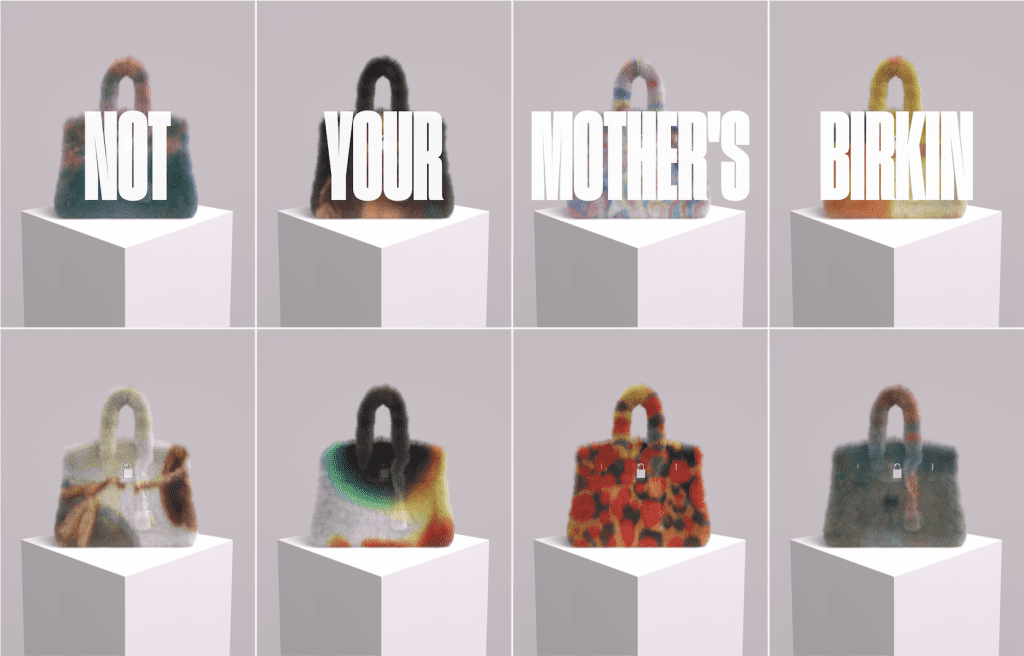Non-fungible tokens (“NFTs”) – along with “metaverse” – were among some of the buzziest words of the year. No shortage of brands looked to NFTs to provide new and interesting opportunities to promote their products and services, and an avenue to introduce new products; while the metaverse promises to one day be an entirely new playground and marketplace for consumers and companies, alike. However, a field of opportunity can also be a minefield for the unwary. As with many new technologies in the past, questions have arisen as to how traditional intellectual property laws should be applied to NFTs. While it is often copyright law that bears the brunt of such challenges, NFTs have turned the heat on trademark laws this year. Against this background, two cases that are currently ongoing before U.S. courts touch on brand-related issues and offer takeaways for brand owners.
Nike v. StockX and Hermès v. Rothschild
In Nike Inc. v StockX LLC, Nike is suing online marketplace StockX for trademark infringement, unfair competition, trademark dilution, counterfeiting, and false advertising for launching its Vault NFT collection tied to actual Nike sneakers. A key question that has arisen in the case is whether StockX’s NFTs are mere “claim tickets” to facilitate the trading of the physical sneakers to which they are tied (as StockX claims) or digital products in and of themselves. StockX is arguing that it is using NFTs as digital receipts and/or in the same way e-commerce retailers use images and descriptions of products online. Nike, on the other hand, contends that StockX’s NFTs are more than merely digital receipts because they are bundled with additional StockX services and benefits, can be redeemed by StockX for a fee thereby depriving the NFT owners of the physical goods, and are also at times sold for many times more than the price of the actual Nike sneakers at play.
The distinction between claim ticket and digital product is important because if the NFTs are simply claim tickets, as StockX says, Nike could be prevented from enforcing its rights by virtue of the U.S. “first-sale doctrine.” The doctrine prescribes that the enforceability of the trademark (or copyright) in a product is exhausted after the product is first sold by or put into the market under the authority of the trademark owner. If the doctrine applies, Nike may not be able to successfully prevent use of its marks by StockX in connection with the legitimate reselling of Nike sneakers.
In another case, Hermès International et al. v Mason Rothschild, Hermès is suing the creator of a collection of “MetaBirkins” NFTs for allegedly infringing its registered trademarks (for “BIRKIN” and the configuration of its iconic Birkin handbag), false designation of origin, and trademark dilution. The “MetaBirkins” NFTs are associated with digital images, created by Rothschild, of Hermès’ Birkin handbags covered in fur in furtherance of what he claims is “a commentary on fashion’s history of cruelty to animals, and its current embrace of alternative fur-free and textile initiatives.” To be clear, unlike in the StockX case, these NFTs are not tied to physical handbags.
Rothschild sought to get the lawsuit dismissed on the basis that he is shielded from Hermès’ claims by the First Amendment, arguing that he is using “MetaBirkins” as the title of his artworks rather than, as Hermès claims, to identify the source of the NFTs. Under U.S. law, in the context of titles of artistic works, the First Amendment would ordinarily defeat any trademark infringement claim unless the use of the mark has no artistic relevance to the work and/or the use is explicitly misleading as to the source of the works.
However, a New York federal court refused to dismiss the suit on the basis that both of these issues – that is, whether the use of Hermès’ trademarks had artistic relevance or was explicitly misleading – were issues that had to be fully considered by the court. The lawsuit will therefore proceed to trial (unless the parties settle).
Lessons for Brand Owners
There are no clear answers – yet – to many of the issues that are before the U.S. courts when it comes to the realm of NFTs and the metaverse more broadly. However, we can decipher some lessons for brand owners from these enduring legal fights …
1. Consider trademark protection in the metaverse
To succeed in a trademark infringement claim, a brand owner has to show that the alleged infringing goods or services are identical, or at least similar, to the goods and services covered by the brand owner’s trademark registrations. Both Nike and Hermès have a string of registrations for physical goods – footwear or handbags, but neither has protection for virtual versions of these goods. Beginning in October 2021, Nike filed applications to register its marks in connection with “downloadable virtual goods, namely computer programs featuring footwear” (i.e., digital sneaker NFTs) and “retail store services featuring virtual goods, namely footwear” (i.e., a digital sneaker NFT trading platform). However, these applications are still pending as of the time of writing.
As much as brand owners would certainly argue that NFT or other digital versions of their products are extensions of their product lines, albeit in the metaverse, so that a license or authorization is required to trade in such products, it remains to be seen if a court will agree that a virtual version of a good is identical or similar to its physical cousin. The analysis of similarity of goods generally takes into account factors, such as the nature of the goods and their respective uses, users and trade channels. A number of these factors would appear to weigh against a finding of similarity between physical and virtual products.
Notably, under trademark law, a mark can be accorded extended protection – for dissimilar goods and services as well – if the brand owner can show that the mark is “well-known” in the jurisdiction in question. However, most brands will find it difficult to surmount the high threshold of proof required. Additionally, while a brand owner could rely on alternative causes of action that are not reliant on a showing of goods similarity, these are subject to their own unique requirements and challenges.
Therefore, brand owners may wish to consider extending the protection for their marks to the digital realm and obtain registrations not just for physical goods and services but also virtual versions of the same. (It is worth noting that in the U.S., actual use of a mark gives rise to rights, making it so that Nike, for instance, which has been using its marks way of partnerships with video game companies, such as Xbox, for years, and more recently, with Roblox, has rights in its well-known marks for use on virtual goods and services even if it does not yet have NFT or metaverse-specific registrations.)
Thinking even further ahead, given the explosion in digital activity in recent years and the potential to exploit their brand assets even more, brand owners may wish to explore the range of practical use cases for NFTs (for instance, e-gaming) and seek protection in the relevant classes to facilitate exploitation and enforcement.
2. Potential challenges with establishing confusion
A key element of claims based on trademark infringement and passing-off (which is a common law tort premised on misrepresentation) is the requirement to establish a likelihood of confusion (that is, that consumers may be confused as to the source of the alleged infringer’s goods or services). In other words, in order to succeed in an infringement claim, a trademark holder would need to show that consumers would be misled into believing that the alleged infringing NFT originates from or is somehow related to the trademark owner.
However, there could be a plethora of factors that impact the issue of “confusion” that should form part of a brand owner’s considerations when evaluating the merits of any enforcement action – for instance:
Disclaimers – The presence of a disclaimer on the NFT platform could serve to dispel possible confusion. For instance, StockX is arguing that its users are not confused about the nature of the Vault NFTs because its website makes it clear that its NFTs are “not affiliated or associated with, sponsored, by, or officially connected to Nike…” and that Nike’s marks are used “solely to refer to the physical product to which [its NFT] corresponds.” Nike, however, contends that this disclaimer is not noticeable to potential buyers of the StockX NFTs, and therefore, ineffective.
(In the MetaBirkins case, Hermès goes so far as to argue that the disclaimer on the MetaBirkins website is not only ineffective because it is “absent from all other channels upon which the NFTs are promoted and/or sold,” but actually makes matters worse, as it “excessively uses the HERMÈS mark three times,” and also “unnecessarily links to Hermès’ website and capitalizes the HERMÈS mark,” thereby, creating “a confusing impression among consumers as to Hermès’ sponsorship of the MetaBirkins NFTs and the MetaBirkins website.”)
Identity of the creator – Another consideration is the identity of the creator and whether the offending NFTs are offered as part of a line. In particular, the offer by a platform or business of a branded NFT that is part of a line would seem to be more suggestive of some form of collaboration with or endorsement by the brand owner, than an offer by an individual end-user of a standalone NFT.
Physical NFTs – Physical NFTs are NFTs (i.e., digital code) that are tied to physical goods, such as StockX’s Vault NFTs. This type of NFT has been touted as being useful in tracking the provenance of and title to goods, such as fine art, wine, and other collectibles. The more widely physical NFTs are used for such purposes, the more likely that consumers will view them as being mere digital tools to facilitate trading, rather than products in and of themselves, and the less likely that they will be misled into thinking that a NFT linked to a particular branded good must originate from the brand owner.
3. Copyright infringement as a possible back-up claim
Another avenue for brand owners to consider when dealing in the virtual realm is copyright. Copyright infringement is not reliant on considerations of the similarity of the goods/services or consumer perceptions, but instead, is premised on the unauthorized reproduction and dissemination of the copyrighted work. As such, if there is a challenge with establishing the elements of the trademark-related causes of action, copyright infringement potentially could serve as an alternative ground of complaint. The main challenges on this front lie in tackling possible “fair use” defenses, and in some cases, with establishing copyright ownership.
The Singapore Copyright Act 2021 provides for a U.S.-style general fair use defense, which is not purpose-specific, but instead, looks to a list of non-exhaustive factors, including the purpose and character of the alleged infringing use, and its effect on the potential market for or value of the original work in determining whether a particular use is “fair.” Additionally, while there is no equivalent of the U.S. First Amendment (i.e., free speech) rights in Singapore, there is a specific defense of fair use for the purpose of criticism or commentary.
First use defenses are likely to be raised in the NFT scenario. For the general fair use defense, a key question would be whether use of works in connection with NFTs can be said to be “transformative” in the sense that an NFT adds something new and is used for a further purpose. The specific defense for criticism or commentary, on the other hand, could potentially apply in a scenario akin to that in the “MetaBirkins” case, at least in theory, given Rothschild’s argument that he is using the underlying artworks as a commentary on luxury goods and the practices of the industry.
It is also important to note the potential challenges in establishing copyright ownership, which could derail enforcement efforts. While Singapore provides a statutory presumption of ownership, this can be challenged by the defendant in good faith, upon which the claimant will have to prove ownership. For many rights holders, this could pose a challenge where there is no clear chain of title or records are patchy, or where the infringing NFTs are based on a fictional character that has been widely depicted or represented, making it difficult to trace the lineage of the particular work or works that have been misused.
Going Forward
With the foregoing in mind, there is increasing speculation that many NFTs lost their luster given the plethora of legal issues, commercial risks, market fluctuations, and other uncertainties. Even so, given the relatively low gas fees (to mint an NFT) and the potential promise of high returns, there remains a draw – even if it involves companies revisiting how, exactly, they will utilize and present this technology to consumers going forward. In light of such potentially enduring relevance for NFTs, brand owners will likely face this phenomenon for some time to come.
The outcomes of the Nike v. StockX and MetaBirkins cases will undoubtedly have a significant impact on how brand owners and IP users alike navigate the NFT minefield in the future. Until then and given the highly uncertain landscape, brand owners will be well advised to ensure that they have a good grasp of their rights, along with the relevant facts before charging forwards with all guns blazing. Fundamentally, it is also timely for brand owners to conduct an audit of their existing intellectual property portfolios to identify any gaps in chain of title or protection, and to plug these gaps, if necessary, to ensure that they are well placed to tackle the challenges to come as companies exploit what the digital realm has to offer.
Lorraine Tay is the joint managing partner of Bird & Bird ATMD and head of the firm’s Intellectual Property Group in Singapore.
Pin-Ping Oh is a partner in Bird & Bird’s Intellectual Property Group in Singapore and part of the Media, Entertainment & Sports team.











